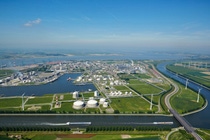Media
BASF builds new plant for alkylethanolamines at Antwerp site
- Increase of BASF’s global alkylethanolamines capacity to 140,000 metric tons per year
- Growing customer demand for versatile intermediate products
BASF builds a new world-scale production plant for alkylethanolamines at the Verbund site in Antwerp, Belgium. After the planned start-up in 2024, the company will increase the global annual production capacity of its alkylethanolamines portfolio containing, amongst others, dimethylethanolamines (DMEOA) and methyldiethanolamines (MDEOA) by nearly 30 percent to more than 140,000 metric tons per year. With a high degree of local backward integration, BASF ensures a reliable and sustainable production of alkylethanolamines. With production facilities for this portfolio at its sites in Ludwigshafen, Germany; Antwerp, Belgium; Geismar, Louisiana and Nanjing, China, BASF is one of the world’s leading producers of alkylethanolamines.
“We see a continuing, growing demand for alkylethanolamines in a broad range of industries such as water treatment, detergents and gas treatment over the next years. The investment in Antwerp will have a positive effect on the available capacity for alkylalkanolamines in BASF’s amines Verbund, therefore supporting our continued ambition to provide products for our customers’ growth,” said Dr. Frank Stein, Regional Business Unit Europe of BASF’s Intermediates division, adding: “This is our clear commitment as one of the globally leading amines producers.”
The versatile alkylethanolamines are mainly used as precursors for flocculants applied in water treatment and in the coatings industry where they act as binders between pigments and resins. Other applications include gas treatment, fabric softeners, in additives for metalworking fluids and polyurethanes.
With about 300 different amines, BASF has the world’s most diverse portfolio of this type of chemical intermediates. Along with alkyl-, alkanol- and alkoxyalkylamines, the company offers heterocyclic and aromatic as well as specialty amines. The range is completed by an expanding portfolio of chiral amines of high optical and chemical purity. The versatile products are used mainly to manufacture process chemicals, pharmaceuticals and crop protection products, as well as cosmetic products and detergents. They also serve to produce coatings, special plastics, composites and special fibers.
Receive up-to-date news releases from BASF via push notification on your smartphone. Register for our news service at basf.com/pushnews.
About BASF Intermediates
The BASF Group’s Intermediates division develops, produces and markets a comprehensive portfolio of more than 600 intermediates around the world. Its most important product groups include amines, diols, polyalcohols, acids and specialties. Intermediates are for example used as precursors for coatings, plastics, pharmaceuticals, textiles, detergents and crop protectants. Innovative intermediates from BASF help to improve both the properties of final products and the efficiency of production processes. The ISO 9001 certified Intermediates division operates plants at production sites in Europe, Asia and North America. Around the globe the division generated sales to third parties of about €3,9 billion in 2021. For more information, go to www.intermediates.basf.com
About BASF
At BASF, we create chemistry for a sustainable future. We combine economic success with environmental protection and social responsibility. Around 111,000 employees in the BASF Group contribute to the success of our customers in nearly all sectors and almost every country in the world. Our portfolio comprises six segments: Chemicals, Materials, Industrial Solutions, Surface Technologies, Nutrition & Care and Agricultural Solutions. BASF generated sales of €78.6 billion in 2021. BASF shares are traded on the stock exchange in Frankfurt (BAS) and as American Depositary Receipts (BASFY) in the U.S. Further information at www.basf.com.
P-22-142

